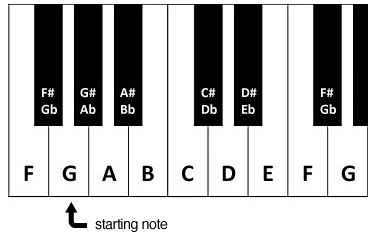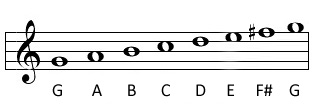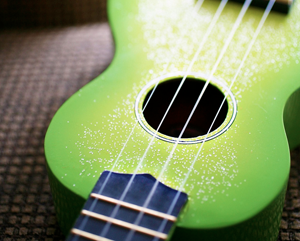Right now, we are in a big lesson series dedicated to learning the ukulele fretboard. We’re doing this by learning all major scales in the twelve different keys. This is the second lesson in the series. If you’re just joining us, welcome!
In the first lesson, we looked at how to play a C major scale on the ukulele. By now, you should be able to comfortably play a C major scale in all positions across the ukulele fretboard.
Learning the C major scale is a critical starting point. All of the lessons from here on out will be building off of our understanding of a C major scale.
So again, if you haven’t learned the C major scale, go here before reading on. If you don’t have a solid understanding of that lesson, this lesson probably won’t make much sense to you.
From here on out, I will be structuring each of these major scale lessons very similarly. First, we will look at the theory behind the scale, or how to build the scale, and then, we will look how to play the scale across the ukulele fretboard.
How to Build a G Major Scale
In the last lesson, we learned that we can build a major scale from any note by applying a whole step, half step interval pattern. We remember that a major scale interval pattern is whole, whole, half, whole, whole, whole, half.
Let’s start on a G note and apply this interval pattern. We will use an example of the piano keys to help us visualize the scale.

From G to A, we have a whole step, from A to B, we have a whole step, from B to C, we have a half step, from C to D, we have a whole step, from D to E, we have a whole step, from E to F#, we have a whole step, and from F# to G, we have a half step.
From this, we see that the notes found in a G major scale are: G, A, B, C, D, E, F#, G.
We can see a G major scale represented on a musical staff:

The most important thing to know about a G major scale is, unlike a C major scale, it has one sharp.
The term “sharp” refers to a note that has been raised a half step. A sharped note is indicated by a “#” symbol. If we go back up to our piano keys example, you’ll see that in order to maintain the whole step, half step interval pattern for a major scale, we had to raise the F natural note up a half step.
Lastly, we can apply this whole step, half step major scale interval pattern to the ukulele fretboard. Because we want to build a G major scale, again, we have to start on a G note and then apply this pattern.
Let’s build a G major scale starting on the open G string:

The blue dots represent the tonic note of the scale (G). Again, if this discussion about whole steps and half steps doesn’t make sense to you, go to the previous lesson to review.
Now that we know how to build a G major scale, let’s learn some more practical ways to play this scale across the ukulele fretboard.
How to Play a G Major Scale on Ukulele
We want to be able to play a G major scale in five different positions across the ukulele fretboard. To do this, we are going to refer to the C major scale we learned in the last lesson. Again, by now, you should be pretty comfortable and familiar with the C major scale.
The cool thing is that you pretty much already know how to play a G major scale. Check this out.
Let’s list the notes in a G major scale:
G, A, B, C, D, E, F#, G
Now, let’s list the notes in a C major scale:
C, D, E, F, G, A, B, C
Tell me. Which single note is found in the G major scale that isn’t found in the C major scale?
The F# is the only different note.
This means all we need to do is take our C major scale positions that we learned in the last lesson and raise all the F notes up a half step to F#. If we do that for each of the five positions we learned, we have completely learned how to play a G major scale in all positions across the ukulele fretboard!
Pretty nifty, huh?
G Major Scale: Position #1

For this position, assign your index finger to fret any of the notes that fall in the 1st fret, your middle finger to fret any of the notes that fall in the 2nd fret, your ring finger to the 3rd fret, and your pinky to the 4th fret.
Compare this position with the first position of the C major scale. As you can see, it’s not much different. We are just raising up the F note to an F# on the second to bottom string.
G Major Scale: Position #2

Like the last position, assign your index, middle, ring, and pinky finger to fret the notes that fall between the 2nd and 5th frets.
G Major Scale: Position #3

This position is a little different. For the notes on the top two strings, your four fingers will hover over the 4th to 7th frets. When you get to the notes on the bottom two strings, your fingers will shift to hover over the 5th to 8th frets to fret the notes.
G Major Scale: Position #4

Like the last position, for the notes on the top two strings, your four fingers should hover over the 6th to 9th frets. When you get to the notes on the bottom two strings, your fingers will shift to hover over the 7th to 10th frets.
G Major Scale: Position #5

Assign your four fingers to fret the notes that fall between the 9th and 12th frets.
How to Practice These Scale Positions
Since you know how to play a C major scale, the G major scale shouldn’t throw you for too much of a loop. The key with practicing these new positions is to be very conscious and aware of what notes you are playing.
As you’ll notice, there are already some patterns repeating themselves between these two scales. For example, if you look at position #4 of the C major scale, and then compare it with position #2 of the G major scale, it’s the exact same fingering.
You’ll notice that these positions will repeat themselves like this in different places on the fretboard for different scales.
This is great because our fingers get used to these different positions pretty quickly. However, this can cause a bit of a challenge in the long run because we don’t want to just be learning the finger patterns. What we really want to know is what notes we are plucking and why we are plucking them. So again, as you pluck each note of these scales, continue to verbalize the note you are plucking.
As you practice the G major scale, continue to incorporate the C major scale in your practice too.
Final Notes
There is a lot in this lesson!
Take your time with it. It’s possible you’ll need to spend a couple weeks on all of this. If something didn’t make sense, don’t hesitate to reread it.
In the last lesson, there were a lot of great questions that were brought up in the comments area. When we’re looking at a topic like scales, there are bound to be a lot of different questions. This is good! Chances are somebody else is asking those same questions too, so don’t be shy.
Post your questions and comments below.
G Major Scale: All Positions



